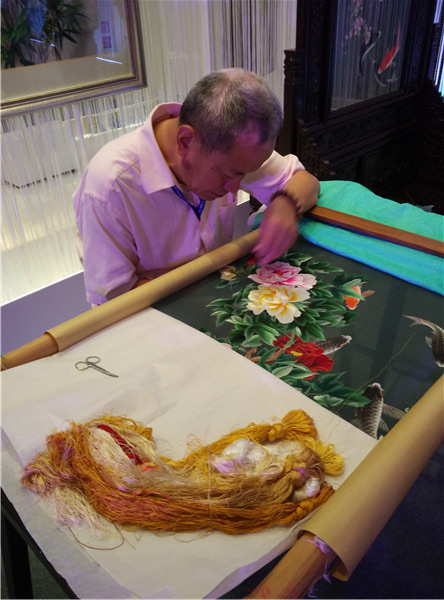 |
|
Peng Shiping showcases his skill of Shu embroidery, a Sichuan tradition, at the ongoing International Festival of Intangible Cultural Heritage in Chengdu. [Photo by Wang Kaihao/China Daily] |
Peng Shiping, a native of Chengdu, the capital of Southwest China's Sichuan province, has been doing Shu embroidery for decades now.
Shu is the abbreviated form of Sichuan used in the old days, and the origins of the craft, one of the four renowned types of Chinese embroidery, go back more than 2,000 years.
But despite its labor-intensive nature and the march of modernization and industrialization, Peng is confident that the craft will survive.
"We've developed a sustainable system of recruiting new blood from schools. The younger generation is willing to take over our jobs," says Peng, 54, an employee of the Shu Brocade Institute.
While he showcased his skill on the opening day of a biennial International Festival of Intangible Cultural Heritage in Chengdu on Friday, Peng stopped every now and then to proudly display the delicate pieces he had crafted and spoke of their traditions to overseas visitors.
While a less than 1-square-meter piece of embroidery usually takes him a year of intense work, once it is done, it can sell for about 500,000 yuan ($78,400).
Shu embroidery was named a national intangible cultural heritage in 2006.
However, despite Peng's confidence not everyone shares his optimism as was evident from speaking to some from the hundreds of Chinese inheritors of such heritage from the country and abroad who had gathered at a massive exhibition center in Chengdu for the event, among China's biggest heritage expos.
Yuma Taru, an Atayal woman from Taiwan's Miaoli county, has grown up making traditional woven pieces.
She says modern lifestyles had left limited space for her craft.
She displayed an album showing pictures of some delicate patterns.
"These can be seen only in museums. We don't make them anymore in our tribe," she says, sounding sentimental.
So how does one keep cultural diversity alive via the inheritance of ICH as we modernize? This was the focus of the forum at this year's festival, the fifth in a series.
"There is a misconception that modernization means industrialization," says Lyu Pintian, deputy director, Chinese National Academy of Arts.
"But, industrialization has reduced the possibility of cultural diversity in modern times, he adds.
"ICH items are closely connected with the areas they are from. So if we want to make sure that they reflect cultural diversity, we have to make sure that these diverse lifestyles still exist."
ICH should not be overwhelmingly influenced by industrial manufacturing processes, Lyu says.
"Folk art cannot only be admired by people without participation, but it's not appropriate to make economic considerations the only direction."
According to him, the production of ICH items to merely make money doesn't work.
However, modernization isn't necessarily harmful to ICH, as it can provide new avenues for the protection of heritage.
Xu Yiyi, a history professor from Nanjing University, says that some people today want more exquisite lifestyles, which has created room for the revitalization of traditional craftsmanship.
"ICH items are actually traditions to live everyday life," Xu says.
"Though we have to understand that the younger generation's habits are far from tradition, modernization also saves time for people and enables them to consider resuming exquisite lifestyles of the old times."
He says that "uncertainty" is one of the charms of ICH, which echoes modern society's need for creativity and to get away from uniform industrial products.
For example, according to Zhong Bingzhang, director of the Shu Brocade Institute, the successful revitalization of the traditional weaving technique since 2002 was partially grounded in the effort to turn the products from a dying daily consumer item into a cultural luxury for modern people.
"Creativity which deviates from the original spirit is not acceptable," Zhong says.
"But it is also not appropriate to do everything the way it was done in ancient times if we want to preserve them (techniques)."
Still, many intangible treasures fade away before people can give them new roles.
"Our goal is not to protect all ICH," says Hu Xiaohui, a researcher at the Chinese Academy of Social Sciences. "But, we can select the most representative ones and protect them to enhance inclusiveness between different civilizations."
Perhaps, what Yuma Taru kept telling visitors to her booth represents the ICH inheritors' common voice: "We've understood the pain of losing (tradition). If your traditions are still alive, please make sure to hold onto them. Once they are lost, it's too hard to get them back."
If you go
The 5th International Festival of Intangible Cultural Heritage runs till Sept 20.
Chengdu International Intangible Cultural Heritage Park Section 2, Guanghua Dadao, Qingyang district.
9 am-5:30 pm. Free entry to the park, but entry to the International ICH exhibition is 15 yuan a person during the festival (Park entry is 50 yuan after the festival ends.)
There are also satellite venues in Chengdu, and several other cities in Sichuan.
For more information visit the official website: www.cdich.net
|
|
|
|
|
|
|
|
